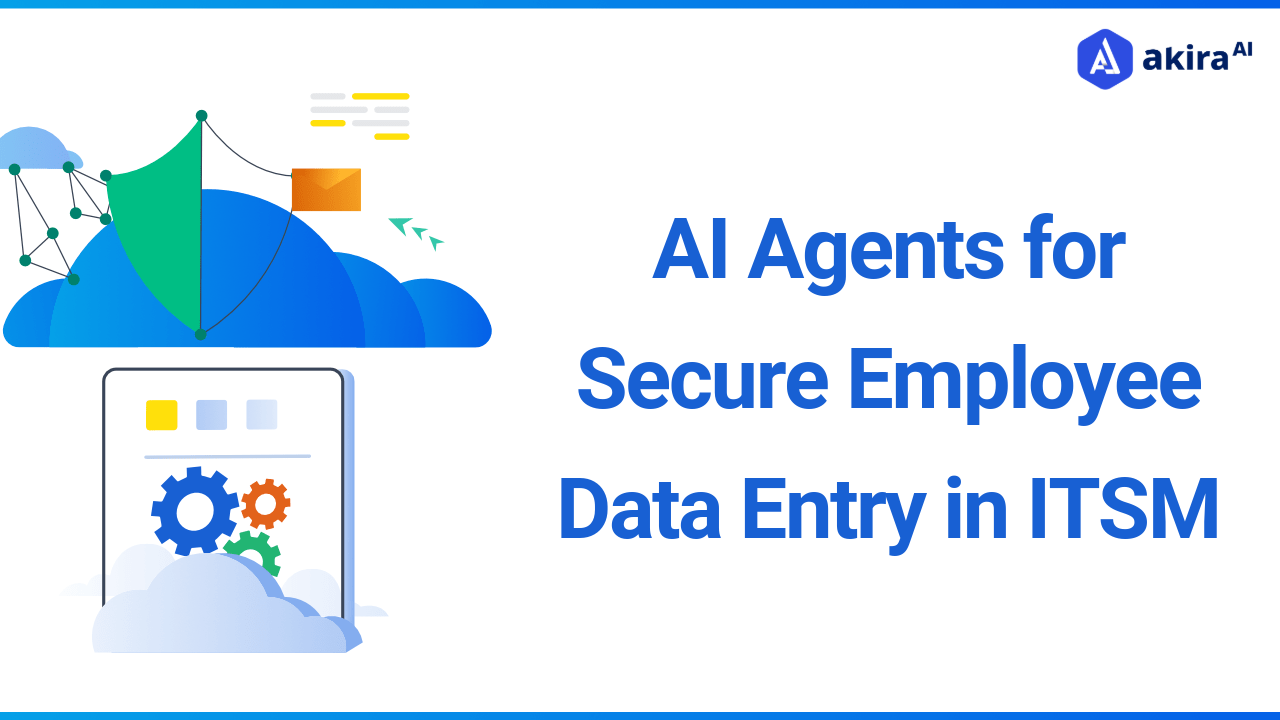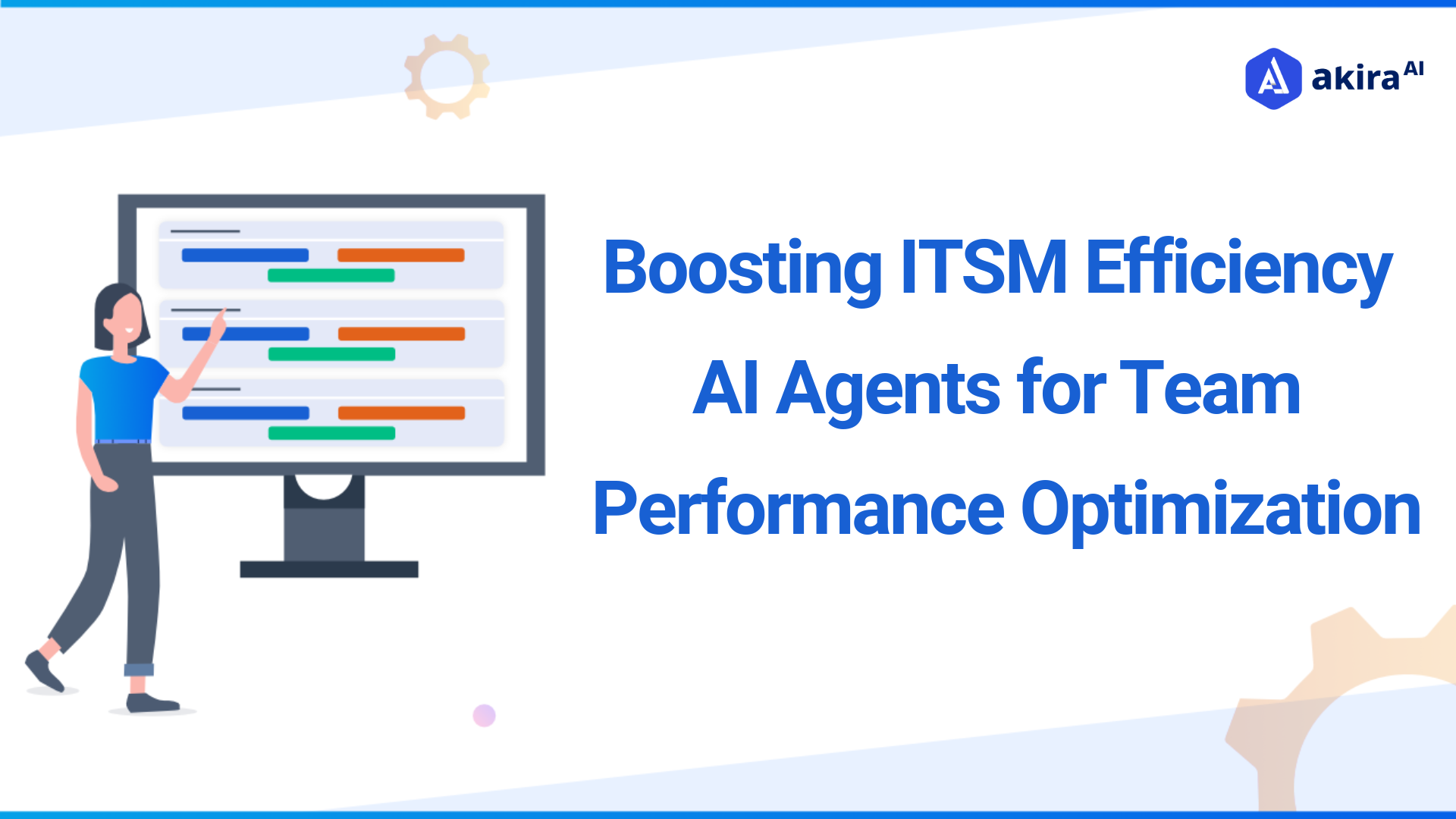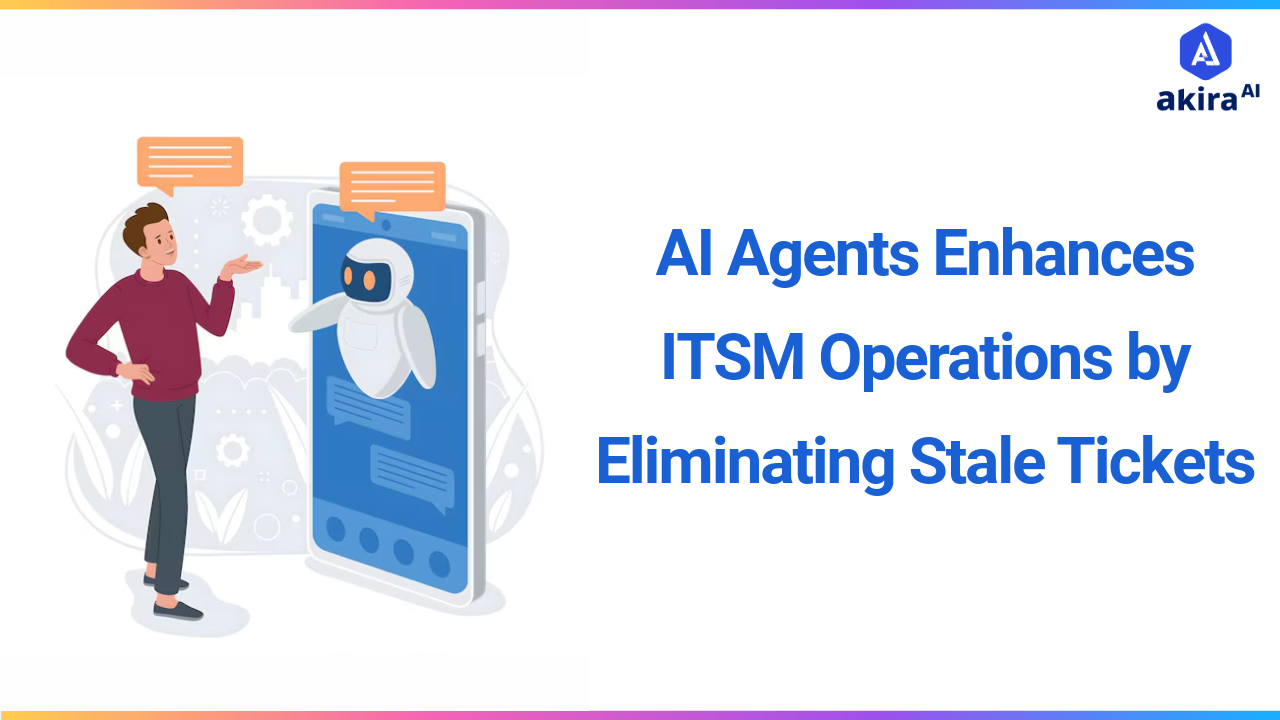Key Insights
-
AI Agents Automate Employee Data Entry: Reduces manual effort and errors by capturing, validating, and updating employee data in ITSM and security systems.
-
Intelligent Agents Streamline Identity Management & ITSM: Automates user access, role-based controls, and compliance tracking across platforms like ServiceNow and Microsoft Entra ID.
-
Security & Compliance Monitoring: Detects anomalies, prevents unauthorized access, and ensures regulatory adherence through continuous data validation.

At a leading financial services firm, a small data entry mistake led to a major security incident. An employee was granted higher access privileges than required, exposing sensitive customer data to unauthorized users. This error went unnoticed until a compliance audit flagged the discrepancy, resulting in a costly investigation and regulatory fines.
Such incidents highlight the risks of manual data entry in ITSM—errors, security gaps, and compliance failures. This blog’ll explore how AI agents transform ITSM, ensuring secure, efficient, and error-free employee data entry while strengthening identity management and compliance.
What is Employee Data and Capture Entry?
In IT Service Management (ITSM) and Security Operations (SecOps), employee data capture and entry involve collecting and recording employee information to manage IT access, security, and compliance. This includes user identities, job roles, device details, access levels, and security credentials.
Captured data is entered into ITSM tools (e.g., ServiceNow, BMC Remedy) for incident management and service requests and security systems (e.g., SIEM, IAM) for monitoring and compliance. Proper data entry ensures accurate user access, reduces security risks, and enhances IT service efficiency.
It plays a crucial role in identity management, incident response, and audit readiness, helping organizations enforce access control, detect anomalies, and comply with regulations like GDPR or HIPAA.
Key Concepts in Employee Identity Management
The key concepts that form the foundation of ITSM and security operations in employee data management include automation, data protection, incident management, and compliance. These concepts directly influence how data is captured, processed, and stored.
Identity Lifecycle Management: Manages user identities from onboarding to offboarding, ensuring proper access throughout employment.
Role-Based Access Control (RBAC): Assigns permissions based on job roles, reducing unauthorized access and enforcing least privilege.
Authentication & Authorization: Uses methods like Multi-Factor Authentication (MFA) and Single Sign-On (SSO) to verify and control user access.
Privileged Access Management (PAM): Protects high-risk accounts by enforcing strict controls and monitoring privileged user activities.
Identity Governance & Compliance: Ensures compliance with security policies and regulations by monitoring access and enforcing policies.
Traditional Way of Employee Identity Management
In the traditional method, HR departments or IT personnel manually capture and enter employee personal data into ITSM systems.
-
Manual Data Entry: In traditional ITSM systems, HR or IT teams manually enter team member details such as names, job roles, and access permissions into various forms, spreadsheets, or databases. This process was time-consuming and required continuous human effort.
-
High Error Rate: Since data was entered manually, mistakes were common. These could include typos, incorrect job roles, or duplicate records, leading to discrepancies in employee records and potential access issues within IT systems.
-
Lack of Automation: Without automated workflows, the same data had to be re-entered across multiple platforms (e.g., HR systems, ITSM tools, and security databases). This redundancy wasted time and increased the risk of inconsistent data.
-
Security Limitations: Many legacy systems lacked strong security controls such as encryption, access restrictions, or audit logs. This made sensitive employee data vulnerable to unauthorized access, leaks, or cyber threats, especially when transferred between systems.
-
Compliance Challenges: Ensuring adherence to data protection laws (such as GDPR and HIPAA) was difficult in manual systems. IT and HR teams had to track compliance manually, making it harder to verify data accuracy, maintain audit trails, and meet regulatory requirements.
Impact on Customers Due to Traditional Way
The traditional employee personal data management approach often led to several adverse outcomes for employees and the organization. For employees, mistakes in data entry could lead to incorrect payroll, benefits issues, or delays in onboarding. Such errors could result in frustration, a lack of trust in the organization, and poor employee experience.
The organization felt the impact of inefficiencies and a higher chance of security breaches. Inaccurate data could lead to compliance failures, attract legal penalties, and damage the company’s reputation. Furthermore, with data spread across different systems and departments, the ability to respond quickly to security incidents was compromised, increasing the risk of data loss or theft.
From a customer standpoint, if employee data was mishandled, it could affect customer-facing services, leading to delays, service interruptions, or poor experiences. In industries like healthcare or finance, where employees have access to highly sensitive customer information, the mismanagement of personal data could result in severe regulatory consequences and loss of client trust.
Akira AI: Multi-Agent in Action
AI agents can be deployed to analyze employee personal data at multiple levels, ensuring that it is captured, processed, and stored in compliance with security protocols. Here’s how specific AI agents can help:
 Fig1: Architecture Diagram of Employee Identity Management
Fig1: Architecture Diagram of Employee Identity Management
-
Data gathering: The Data Capture Agent can automate the collection of employee data, extracting relevant details from documents, forms, or databases. This agent validates the information as it is entered, reducing the chances of errors and ensuring accurate data capture.
-
Data ingestion: The Data Entry Agent can be integrated with ITSM systems to input data into the appropriate fields automatically. This reduces the need for manual data entry, improves efficiency, and eliminates common mistakes when data is entered by hand.
-
ITSM Ticketing Agent: An ITSM Ticketing Agent is responsible for creating, updating, and managing IT service tickets based on employee requests or incidents. They ensure proper categorization, prioritization, and resolution tracking for efficient IT support and service management.
-
Security and Compliance: The Security and Compliance Agent continuously monitors employee data to ensure it is handled securely and complies with regulations like GDPR or HIPAA. This agent can detect and alert administrators to breaches or deviations from standard security practices, ensuring data protection requirements are met.
-
Incident Reporting: The Incident Response Agent is used in security operations to analyze data patterns and trigger responses to potential security incidents in real time. By automating threat detection, this agent helps security teams respond quickly and effectively to emerging threats, minimizing the risk of data breaches or other security issues.
Prominent Technologies in the Space of Employee Identity Management
Several technologies have emerged in recent years to address the limitations of traditional methods for employee data capture and entry. These technologies aim to automate, secure, and streamline the process, ensuring compliance while enhancing operational efficiency.
-
Identity and Access Management (IAM) Systems: Platforms like Okta, Microsoft Entra ID (Azure AD), and Ping Identity manage authentication, authorization, and access control.
-
Privileged Access Management (PAM) Solutions: Tools like CyberArk and BeyondTrust protect privileged accounts, preventing unauthorized access to critical IT systems.
-
Single Sign-On (SSO) & Multi-Factor Authentication (MFA): Technologies like Duo Security, Google Authenticator, and Microsoft Authenticator enhance security by enabling seamless authentication and extra verification layers.
-
Identity Governance and Administration (IGA): Solutions like SailPoint, Saviynt, and ServiceNow Identity Governance help enforce compliance, automate user lifecycle management, and manage role-based access.
-
ITSM & Security Operations Platforms: ServiceNow ITSM & SecOps integrate identity management with IT workflows, enabling automated access provisioning, incident tracking, and compliance enforcement.
Successful Implementations of AI Agents
Several organizations have successfully implemented AI-driven solutions for managing employee personal data. Here are four real-world examples showcasing the impact of AI agents:
-
Deloitte: Integrated ServiceNow ITSM & Workday HR with AI and RPA to automate employee data entry, reducing manual effort by 80%. AI-driven validation improved data accuracy and ensured compliance with GDPR.
-
IBM: Leveraged IBM Watson AI with HR systems like SAP SuccessFactors to automate employee data collection, reducing onboarding time and minimizing human errors in ITSM and security operations.
-
Microsoft: Used Microsoft Entra ID (Azure AD) & AI-driven IAM to streamline identity verification and access control, ensuring secure and efficient employee data management across global offices.
-
HSBC: Implemented AI-powered chatbots & RPA in ServiceNow to handle employee data updates, automate IT ticketing, and improve compliance tracking, reducing security risks and operational costs.
How AI Agents Supersede Other Technologies
-
Autonomous Data Management: Intelligent agents will handle employee data entry without human oversight, ensuring seamless updates across ITSM, HR, and security platforms. These agents will input data and validate and correct inconsistencies in real time.
-
Self-Learning & Adaptive Processing: Future systems will continuously improve by analyzing patterns in employee data entry. They will refine processes, minimize errors, and adjust to regulatory changes dynamically, reducing the need for manual intervention.
-
Context-Aware Decision Making: Smart agents will understand company policies, job roles, and security protocols, allowing them to determine appropriate data handling procedures. This will help manage role-based access and prevent unauthorized modifications.
-
Unified Workflow Integration: Employee records will be synchronized across multiple platforms, such as Workday, ServiceNow, and Microsoft Entra ID. Updates made in one system will automatically reflect across all linked platforms, reducing duplication and inconsistencies.
-
Proactive Security & Compliance Monitoring: Automated systems will detect anomalies, flag potential compliance violations, and generate audit reports. This ensures data integrity while simplifying adherence to regulations such as GDPR and HIPAA.
Next Steps with AI Agents
Talk to our experts about implementing compound AI system, How Industries and different departments use Agentic Workflows and Decision Intelligence to Become Decision Centric. Utilizes AI to automate and optimize IT support and operations, improving efficiency and responsiveness.



